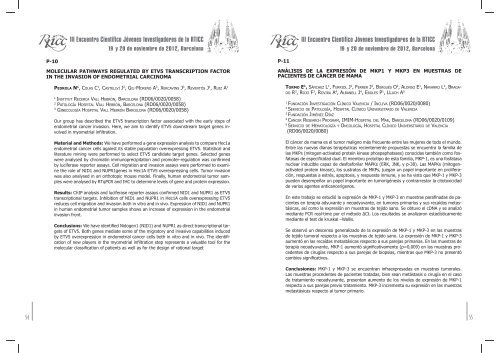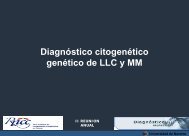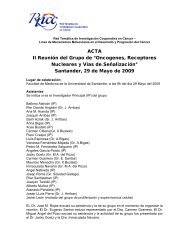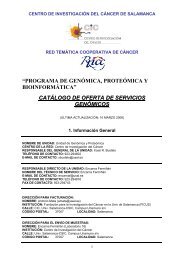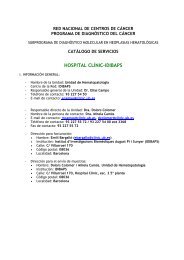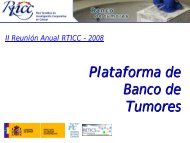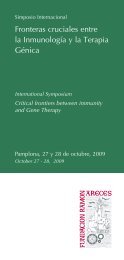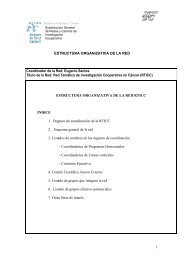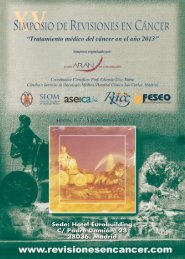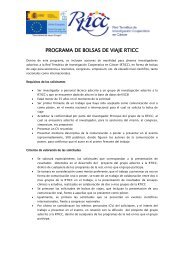Untitled - Red Temática de investigación cooperativa en cáncer
Untitled - Red Temática de investigación cooperativa en cáncer
Untitled - Red Temática de investigación cooperativa en cáncer
You also want an ePaper? Increase the reach of your titles
YUMPU automatically turns print PDFs into web optimized ePapers that Google loves.
P-10<br />
MOLECULAR PATHWAYS REGULATED BY ETV5 TRANSCRIPTION FACTOR<br />
IN THE INVASION OF ENDOMETRIAL CARCINOMA<br />
PEDROLA N 1 , COLAS C 1 , CASTELLVÍ J 2 , GIL-MORENO A 3 , XERCAVINS J 3 , REVENTÓS J 1 , RUIZ A 1<br />
1<br />
INSTITUT RECERCA VALL HEBRÓN, BARCELONA (RD06/0020/0058)<br />
2<br />
PATOLOGÍA HOSPITAL VALL HEBRÓN, BARCELONA (RD06/0020/0058)<br />
3<br />
GINECOLOGÍA HOSPITAL VALL HEBRÓN BARCELONA (RD06/0020/0058)<br />
Our group has <strong>de</strong>scribed the ETV5 transcription factor associated with the early steps of<br />
<strong>en</strong>dometrial cancer invasion. Here, we aim to i<strong>de</strong>ntify ETV5 downstream target g<strong>en</strong>es involved<br />
in myometrial infiltration.<br />
Material and Methods: We have performed a g<strong>en</strong>e expression analysis to compare Hec1a<br />
<strong>en</strong>dometrial cancer cells against its stable population overexpressing ETV5. Statistical and<br />
literature mining were performed to select ETV5 candidate target g<strong>en</strong>es. Selected g<strong>en</strong>es<br />
were analysed by chromatin immunoprecipitation and promoter-regulation was confirmed<br />
by luciferase reporter assays. Cell migration and invasion assays were performed to examine<br />
the role of NID1 and NUPR1g<strong>en</strong>es in Hec1A ETV5 overexpressing cells. Tumor invasion<br />
was also analysed in an orthotopic mouse mo<strong>de</strong>l. Finally, human <strong>en</strong>dometrial tumor samples<br />
were analysed by RTqPCR and IHC to <strong>de</strong>termine levels of g<strong>en</strong>e and protein expression.<br />
Results: ChIP analysis and luciferase reporter assays confirmed NID1 and NUPR1 as ETV5<br />
transcriptional targets. Inhibition of NID1 and NUPR1 in Hec1A cells overexpressing ETV5<br />
reduces cell migration and invasion both in vitro and in vivo. Expression of NID1 and NUPR1<br />
in human <strong>en</strong>dometrial tumor samples shows an increase of expression in the <strong>en</strong>dometrial<br />
invasion front.<br />
Conclusions: We have i<strong>de</strong>ntified Nidog<strong>en</strong>1 (NID1) and NUPR1 as direct transcriptional targets<br />
of ETV5. Both g<strong>en</strong>es mediate some of the migratory and invasive capabilities induced<br />
by ETV5 overexpression in <strong>en</strong>dometrial cancer cells both in vitro and in vivo. The i<strong>de</strong>ntification<br />
of new players in the myometrial infiltration step repres<strong>en</strong>ts a valuable tool for the<br />
molecular classification of pati<strong>en</strong>ts as well as for the <strong>de</strong>sign of rational target<br />
P-11<br />
ANÁLISIS DE LA EXPRESIÓN DE MKP1 Y MKP3 EN MUESTRAS DE<br />
PACIENTES DE CÁNCER DE MAMA<br />
TORMO E 1 , SÁNCHEZ L 1 , FURRIOL J 1 , FERRER J 1 , BURGUÉS O 2 , ALONSO E 1 , NAVARRO L 2 , BRAGA-<br />
DO R 3 , ROJO F 3 , ROVIRA A 4 , ALBANELL J 4 , EROLES P 1 , LLUCH A 5<br />
1<br />
FUNDACIÓN INVESTIGACIÓN CLÍNICO VALENCIA / INCLIVA (RD06/0020/0080)<br />
2<br />
SERVICIO DE PATOLOGÍA, HOSPITAL CLÍNICO UNIVERSITARIO DE VALENCIA<br />
3<br />
FUNDACIÓN JIMÉNEZ DÍAZ<br />
4<br />
CANCER RESEARCH PROGRAM, IMIM-HOSPITAL DEL MAR, BARCELONA (RD06/0020/0109)<br />
5<br />
SERVICIO DE HEMATOLOGÍA Y ONCOLOGÍA, HOSPITAL CLÍNICO UNIVERSITARIO DE VALENCIA<br />
(RD06/0020/0080)<br />
El cáncer <strong>de</strong> mama es el tumor maligno más frecu<strong>en</strong>te <strong>en</strong>tre las mujeres <strong>de</strong> todo el mundo.<br />
Entre las nuevas dianas terapéuticas reci<strong>en</strong>tem<strong>en</strong>te propuestas se <strong>en</strong>cu<strong>en</strong>tra la familia <strong>de</strong><br />
las MKPs (mitog<strong>en</strong>-activated protein kinase phospaphatases) conocidas también como fosfatasas<br />
<strong>de</strong> especificidad dual. El miembro prototipo <strong>de</strong> esta familia, MKP-1, es una fosfatasa<br />
nuclear inducible capaz <strong>de</strong> <strong>de</strong>sfosforilar MAPKs (ERK, JNK, y p-38). Las MAPKs (mitog<strong>en</strong>activated<br />
protein kinase), los sustratos <strong>de</strong> MKPs, juegan un papel importante <strong>en</strong> proliferación,<br />
respuestas a estrés, apoptosis, y respuesta inmune, y se ha visto que MKP-1 y MKP-3<br />
pue<strong>de</strong>n <strong>de</strong>sempeñar un papel importante <strong>en</strong> tumorigénesis y contrarrestar la citotoxicidad<br />
<strong>de</strong> varios ag<strong>en</strong>tes anticanceríg<strong>en</strong>os.<br />
En este trabajo se estudió la expresión <strong>de</strong> MKP-1 y MKP-3 <strong>en</strong> muestras parafinadas <strong>de</strong> paci<strong>en</strong>tes<br />
<strong>en</strong> terapia adyuvante y neoadyuvante, <strong>en</strong> tumores primarios y sus recaídas metastásicas,<br />
así como la expresión <strong>en</strong> muestras <strong>de</strong> tejido sano. Se obtuvo el cDNA y se analizó<br />
mediante PCR real-time por el método ΔCt. Los resultados se analizaron estadísticam<strong>en</strong>te<br />
mediante el test <strong>de</strong> kruskal –Wallis.<br />
Se observó un <strong>de</strong>sc<strong>en</strong>so g<strong>en</strong>eralizado <strong>de</strong> la expresión <strong>de</strong> MKP-1 y MKP-3 <strong>en</strong> las muestras<br />
<strong>de</strong> tejido tumoral respecto a las muestras <strong>de</strong> tejido sano. La expresión <strong>de</strong> MKP-1 y MKP-3<br />
aum<strong>en</strong>tó <strong>en</strong> las recaídas metastásicas respecto a sus parejas primarias. En las muestras <strong>de</strong><br />
terapia neoadyuvante, MKP-1 aum<strong>en</strong>tó significativam<strong>en</strong>te (p=0,009) <strong>en</strong> las muestras proce<strong>de</strong>ntes<br />
<strong>de</strong> cirugías respecto a sus parejas <strong>de</strong> biopsias, mi<strong>en</strong>tras que MKP-3 no pres<strong>en</strong>tó<br />
cambios significativos.<br />
Conclusiones: MKP-1 y MKP-3 se <strong>en</strong>cu<strong>en</strong>tran infraexpresadas <strong>en</strong> muestras tumorales.<br />
Las muestras proce<strong>de</strong>ntes <strong>de</strong> paci<strong>en</strong>tes tratadas, bi<strong>en</strong> sean metástasis o cirugía <strong>en</strong> el caso<br />
<strong>de</strong> tratami<strong>en</strong>to neoadyuvante, pres<strong>en</strong>tan aum<strong>en</strong>to <strong>de</strong> los niveles <strong>de</strong> expresión <strong>de</strong> MKP-1<br />
respecto a sus parejas previo tratami<strong>en</strong>to. MKP-3 increm<strong>en</strong>ta su expresión <strong>en</strong> las muestras<br />
metastásicas respecto al tumor primario.<br />
54 55


